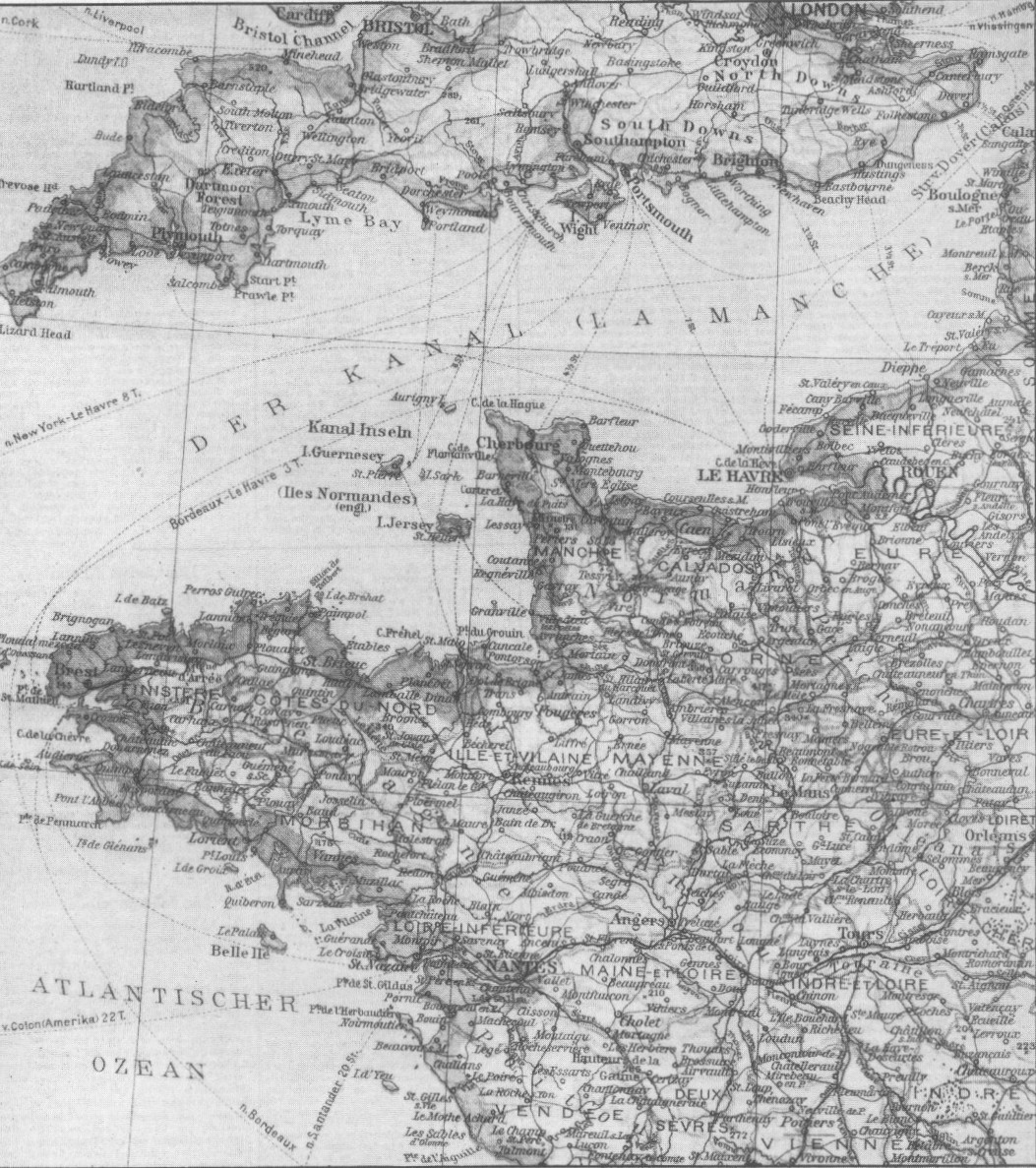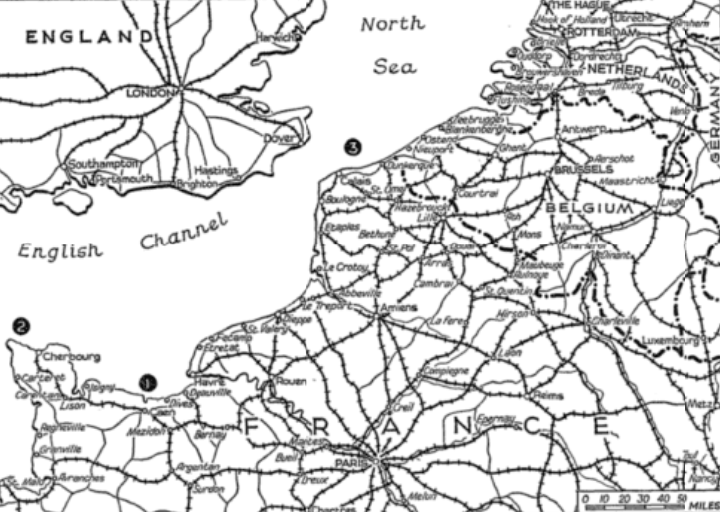Boro millions pray, rejoice or work grimly
Church bells announce news; courts open with brief ceremony
George C. Tilyou, head of Steeplechase Park, Coney Island, said, “The park will be closed today. This is not a day for amusement.”
Brooklyn’s millions greeted news of the invasion today with prayer, with some restrained jubilation and with work.
Men and women gathered in churches, in stores, in shops and factories and courtrooms and prayed for victory and the safe conduct of sons and brothers and husbands through their ordeal by fire on the soil of France. And often the eyes were moist while lips moved in prayer.
Church bells announced the invasion news and almost every church had planned invasion services.
Every Supreme Court part in Brooklyn and Long Island was adjourned until tomorrow, by direction of the Appellate Division. The five County Judges in Brooklyn, after a brief ceremony at noon which included a minute of silent prayer adjourned for the day. Most of the lesser courts also adjourned.
The Brooklyn Hebrew Home and Hospital for the Aged, 813 Howard Avenue, instituted a fast day, along with prayers for the success of the invasion.
Don prayer shawls
News of the invasion reached the institution very early and spread quickly among the 640 elderly inmates. At 5:45 a.m., 15 of the elderly men donned prayer shawls, and carrying shofar, or ram’s horn trumpet – normally blown only twice a year, on the two High Holy Days – paraded through the neighborhood streets, summoned the people to Invasion Day services at the adjoining synagogue. More than 1,000 persons crowded the synagogue hall when prayers for success of the invasion began, at 7:00 a.m. ET.
The sports world marked the day in its own way. The Dodgers-Philadelphia night game at Ebbets Field tonight, the only baseball game in the metropolitan area today, was called off. So were all horse races, not only in the New York area, but throughout the country, except for one racetrack in California. Prize fights scheduled for MacArthur Stadium tonight were put off to tomorrow.
Night war workers were the first in Brooklyn to get word of the invasion… Some wondered, skeptically, if it wasn’t another false report… Some prayed… Some shouted with release of tension long restrained… Many turned grimly back to their worn benches, determined to give the enemy not one moment of time lost.
In the Brooklyn Navy Yard, the borough’s hugest war industry, thousands were at work at 4:30 when a voice broke in abruptly over the loudspeaker system: “The invasion has begun!”
Spontaneously, as if by prearranged signal, workers stood up for a moment of silent prayer, returned at once to their work.
At the Bethlehem Steel yards, the chattering radio interrupted a night music program with the first news of invasion at 4:00 a.m. ET. There was a shouted “hurray!” and then, over the sprawling yards, men in overalls, men holding tools in their hands, stood beside their workplaces while their lips moved in solemn prayer.
At the Bendix Aviation Corporation plants, the first report was the definite and official word from Gen. Eisenhower’s headquarters. And here the men simply bent to their jobs. Said a head timekeeper who had watched the phenomenon:
Nobody stopped. You could hear remarks like, “We’ll clean up the Nazis then get to work on the Japs.” But everyone agreed the best way to help the boys who were going through hell over there was to keep on working.
At the Sperry Gyroscope Company, 40 Flatbush Avenue Extension, some of the night workers declined to believe the first reports as the radio doled them out at 4 o’clock. Then a foreman telephoned, came back with the report that yes, this time it was true. The invasion was on. The men went back to their jobs, worked silently and without interruption.
At the Frederick Loeser store on Fulton shortly after it opened at 9:00 a.m., the entire store personnel gathered on the street floor and, led by Capt. M. M. Witherspoon, chaplain of the 3rd Naval District, joined in prayer for the success of the invasion, the safety of the men in the invading legions.
Capt. Witherspoon read the prayer of Gen. Clark on the eve of the entry into Rome, and then Gen. Eisenhower’s pre-invasion prayer. Then he pronounced his own prayer that God teach us to “catch the spirit this day of the sacrifice by our boys overseas.” Several hundred customers waited in a roped-off area until the employees could return to their normal duties.
Early this afternoon, storekeepers up and down Kings Highway closed their stores and joined with other residents in an open-air invasion rally in Joyce Kilmer Square, Kings Highway and East 12th Street. Clergymen of every denomination led in prayers.
In the Midwood section, the neighborhood merchants held a similar mass meeting at Avenue and East 14th Street. Prayers were offered by Rabbi M. J. Mintz.
At the Wheeler Shipyards, Cropsey Avenue, and Coney Island Creek, several hundred workers joined in a brief prayer service.
There was an outdoor prayer service by the men of the Naval Receiving Barracks, Flushing and Vanderbilt Avenues, at 8:00 a.m. Civilian passersby paused and stood at a strict attention.
The Brooklyn Jewish Center, 667 Eastern Parkway, it was announced, will hold D-Day services at 8:30 p.m.
Alfred B. Auerhaan, safety director of the Arma Corporation, announced that Arma employees responded to the invasion news by 300 of them offering to visit the Red Cross Blood Donor Center, 57 Willoughby Street, and donating a pint of blood each. That will bring Arma employees’ total to more than 1,000 pints since Jan. 1 – a record equaled or exceeded only by the Brooklyn Navy Yard.
Person riding on the subway trains readily spoke to perfect strangers today when the subject was the invasion. Many said that, recalling the false armistice of the last war and how quickly it was followed by the real armistice, suspected that the unauthorized Associated Press report of the invasion Sunday “meant something.”
Employees of the Borough President’s office were given two hours off about noon today for Invasion Day prayers. The majority visited churches but a few visited their homes during the work intermission.
Greatest merchant fleet backs invasion of ‘Fortress Europa’
By Sandor S. Klein, U.S. staff correspondent
Washington –
The “Western Front” invasion of Europe is backstopped by the greatest merchant fleet in world history.
Today these ships are carrying men and supplies from this great “arsenal of democracy” in numbers and quantities that dwarf anything seen in the last World War. And they are doing it in comparative safety, thanks to the Allied victory over Germany’s vast U-boat fleet in the Battle of the Atlantic.
Adolf Hitler had counted on submarines to thwart the long-planned Allied invasion of “Fortress Europe.” But his trump wasn’t high enough. The United Nations drew a higher hand. For months now, Allied sea and air forces have been destroying U-boats faster than Germany can build them and preventing those escaping destruction from doing much harm. Some ships are still being sunk but they are comparatively few in number; fewer, in fact, than the number of U-boats that are being destroyed.
The exact number of merchantman ships available is not known. But this is certain from production figures available: The so-called “bridge of ships” which did so much to bring victory to the Allies in the last war was a narrow catwalk compared to the great merchant armada spanning the Atlantic today.
By the summer of 1942, the navy and the army had perfected anti-submarine methods. Using everything it had in the way of small craft the navy began escorting coastal convoys. Army and navy planes coordinated their offshore patrol activities. By the fall of the year, the U-boats were finding it tougher and began moving into other areas.
Meanwhile, the navy gave top priority to the construction of special types of hundreds of anti-submarine vessels – destroyer-escorts, frigates, patrol boats and corvettes. It turned to the building of dozens of escort aircraft carriers.
By the latter part of 1942, the submarine menace had been brought sufficiently under control to permit U.S. participation in the invasion of North Africa.
Then, last year, as definite plans for the Western Front invasion began to germinate, the Battle of the Atlantic took a new, important turn. The Allies switched from “protective tactics” to a war of extermination against the U-boats. Special escort carrier task forces were turned loose to seek out and destroy U-boats wherever they could be found. These were supplemented by the huge fleet of anti-submarine surface ships and long-range bombing planes.
Meanwhile, Allied bombers operating from Britain smashed at German submarine-building centers, factories producing parts for the submersibles and at U-boat bases along the French and Norwegian coasts.
Thus, Hitler’s navy found itself in a two-way squeeze; one aimed at impairing U-boat production; and the other, striking at the raiders themselves.
Their effectiveness of anti-submarine measures is reflected in the monthly joint Anglo-American announcements of operations issued during the last six months. For example, during the six-month period from May to October 1943, a monthly average of 25 submarines destroyed was chalked up. This is 10 more per month than Nazi shipyards are now believed capable of producing.
Hottelet: Coast guns silent as Allies landed
By Richard C. Hottelet
London, England (UP) –
I watched the first landing barges hit the beach exactly on the minute of H hour. I was in a 9th Air Force Marauder flying at 4,500 feet alone 20 miles of the invasion coast.
From what I could see in these first few minutes there was nothing stopping the assault parties from getting ashore. I spent about half an hour over enemy territory. We flew over and bombed some of the coastal fortifications but, except for some light flak from inland positions and from some types firing at us, we saw no enemy gunfire.
The only other sign of life in enemy territory were some white and yellow parachutes dotting the ground where our parachutists had hit.
The weather was favorable to the operation.
Offshore Allied warships were bombing the enemy coast. They seemed to do it without any opposition. The Luftwaffe just didn’t seem to be there.

